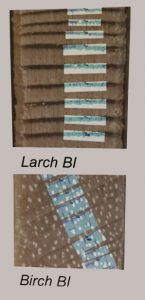Blue intensity (BI) is a relatively new method of measuring the amount of blue light reflected from tree ring cores. In order to conduct blue intensity measurements, the tree ring core is first scanned using a flatbed scanner. The COW Tree Ring Lab then uses CooRecorder to analyze the scans and produce blue intensity data.

Blue intensity tends to follow maximum latewood density, the density of wood that grows late in a tree’s growing season. Maximum latewood density, unlike ring width, may tend to more closely follow year-to-year climate change (“high frequency” changes), rather than changes over decades or longer periods (“low frequency” changes). For this reason, maximum latewood density has been used for years as a method of tree-ring analysis. However, this method of analysis is relatively expensive, limiting its use (Rydval et al., 2014).
BI is much less expensive, but offers similar information. The tests can be conducted using a scanner and a purchased copy of BI software. This new method thus offers the ability to correlate tree rings to climate change at different time scales more easily than before.
BI at the COW Tree Ring Lab
The COW Tree Ring Lab is equipped with a BI station with a copy of the CooRecorder program. BI has already been used in our related projects.
Jeff Gunderson ’17, for example, found that BI in some cases can be used more effectively than ring width to reconstruct glacier mass balance. Eduardo Luna ’18 also made use of BI to look at larch and birch correlations with climate in Kamchatka and the Gulf of Alaska.

It is likely that BI will continue to expand as a method of tree ring analysis at COW Tree Ring Lab and tree ring laboratories around the world. In the future, we hope to use BI to reconstruct more climate variables, particularly summer temperature.
References cited
- Rydval, M., Larsson, L-.A., McGlynn, L., Gunnarson, B.E., Loader, N.J., Young, G.H.F., Wilson, R., 2014, Blue intensity for dendroclimatology: Should we have the blues? Experiments from Scotland: Dendrochronologica, v. 32, p. 191-204. (Read abstract)
Publications using BI related to the COW Tree Ring Lab
(Italics indicate COW undergraduates)
- Gunderson, J.D., Wiles, G., and Wiesenberg, N., 2016, Investigating blue light intensity as a new parameter for tree ring-based glacier mass balance reconstructions in Alaska: Geological Society of America 2016 Annual Meeting, Denver, CO, Abstracts (Read abstract)
- Hilton, A., Wiles, G.C., Happ, M. and Wiesenberg, N., 2016, Analysis of new blue intensity and ring width tree ring chronologies as proxies for North Pacific climate change, Columbia Bay, Alaska: Geological Society of America Abstracts with Programs. Vol. 48, No. 7, doi: 10.1130/abs/2016AM- 282738. (Read abstract)
- McGrath, S., Luna, E.T., Wiesenberg, N., and Wiles, G., 2016, Examining the effects of a changing climate on Alaska Yellow Cedar: Analyses of ring width and blue intensity tree ring chronologies: Geological Society of America 2016 Annual Meeting, Denver, CO, Abstracts (Read abstract)
- Wilson, R., D’Arrigo, R., Andreu-Hayles, L., Oelkers, R., Wiles, G., Anchukaitis, K., and Davi, N., 2017, Blue Intensity based experiments for reconstructing North Pacific temperatures along the Gulf of Alaska: Clim. Past Discuss. doi:10.5194/cp-2017-26. (Read abstract)
